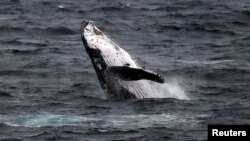A water-proof drone is being used by Australian scientists to collect the highly-treasured nasal mucus of migrating whales. The snot is rich with fresh DNA, viruses and bacteria, and is collected by a drone that hovers over the blowholes of humpback whales as they embark on their epic annual journey along Australia's east coast.
Whales, like all mammals need air, and come to the surface to breathe through a blowhole.
Vanessa Pirotta, a marine biologist at Macquarie University, says that nasal mucus indicates the health of the whale.
“It is the juicy biological mixture that you see as a whale takes a breath as they surface from the water," she said. "You often see that plume and it sounds like this like [sounds of sharp breaths] as a whale breathes because, after all, they are mammals like you and I and they have two nostrils, and it is the humpback whale that I am talking about. So as they take a breath it is a lot of lung bacteria coming out from their lungs, which we can collect to provide a snapshot of whale health.”
Australian researchers have attached a petri dish that is used in scientific tests to a drone which flies through the whale’s nasal mist.
“As a whale comes to take a breath — you can actually see it coming to the surface on really good weather days that is — the drone then lowers, the petri dish is then opened and the drone is flown through the densest part of the whale snot, collecting the sample in the petri dish. Now once this happens the lid is shut and the drone is flown back to the research vessel and we collect the sample to later process it in the laboratory,” said Pirotta.
The research could help to solve one of the mysteries of another magnificent creature of the deep — the Southern right whale. Its numbers have recovered on Australia’s west coast since hunting was outlawed but its population on the eastern seaboard remains stubbornly low.
In the past studies into whale health had to rely on examining whales that were either killed or those whales that had been stranded on a beach.
Drones allow scientists to collect samples from free-swimming whales to gather information in a safe and non-invasive way.








